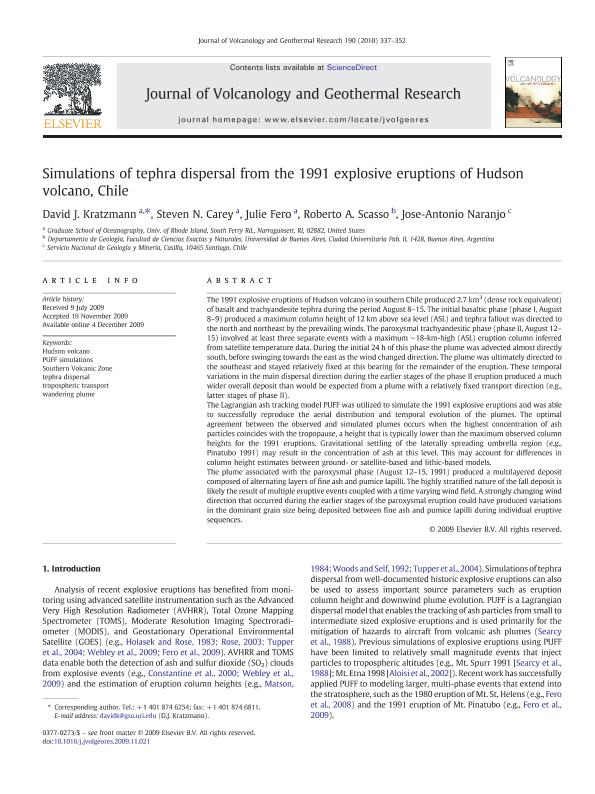Mostrar el registro sencillo del ítem
dc.contributor.author
Kratzmann, David J.
dc.contributor.author
Carey, Steven N.
dc.contributor.author
Fero, Julie
dc.contributor.author
Scasso, Roberto Adrian

dc.contributor.author
Naranjo, Jose Antonio
dc.date.available
2019-01-28T19:16:44Z
dc.date.issued
2010-02
dc.identifier.citation
Kratzmann, David J.; Carey, Steven N.; Fero, Julie; Scasso, Roberto Adrian; Naranjo, Jose Antonio; Simulations of tephra dispersal from the 1991 explosive eruptions of Hudson volcano, Chile; Elsevier Science; Journal of Volcanology and Geothermal Research; 190; 3-4; 2-2010; 337-352
dc.identifier.issn
0377-0273
dc.identifier.uri
http://hdl.handle.net/11336/68795
dc.description.abstract
The 1991 explosive eruptions of Hudson volcano in southern Chile produced 2.7 km3 (dense rock equivalent) of basalt and trachyandesite tephra during the period August 8-15. The initial basaltic phase (phase I, August 8-9) produced a maximum column height of 12 km above sea level (ASL) and tephra fallout was directed to the north and northeast by the prevailing winds. The paroxysmal trachyandesitic phase (phase II, August 12-15) involved at least three separate events with a maximum ∼ 18-km-high (ASL) eruption column inferred from satellite temperature data. During the initial 24 h of this phase the plume was advected almost directly south, before swinging towards the east as the wind changed direction. The plume was ultimately directed to the southeast and stayed relatively fixed at this bearing for the remainder of the eruption. These temporal variations in the main dispersal direction during the earlier stages of the phase II eruption produced a much wider overall deposit than would be expected from a plume with a relatively fixed transport direction (e.g., latter stages of phase II). The Lagrangian ash tracking model PUFF was utilized to simulate the 1991 explosive eruptions and was able to successfully reproduce the aerial distribution and temporal evolution of the plumes. The optimal agreement between the observed and simulated plumes occurs when the highest concentration of ash particles coincides with the tropopause, a height that is typically lower than the maximum observed column heights for the 1991 eruptions. Gravitational settling of the laterally spreading umbrella region (e.g., Pinatubo 1991) may result in the concentration of ash at this level. This may account for differences in column height estimates between ground- or satellite-based and lithic-based models. The plume associated with the paroxysmal phase (August 12-15, 1991) produced a multilayered deposit composed of alternating layers of fine ash and pumice lapilli. The highly stratified nature of the fall deposit is likely the result of multiple eruptive events coupled with a time varying wind field. A strongly changing wind direction that occurred during the earlier stages of the paroxysmal eruption could have produced variations in the dominant grain size being deposited between fine ash and pumice lapilli during individual eruptive sequences.
dc.format
application/pdf
dc.language.iso
eng
dc.publisher
Elsevier Science

dc.rights
info:eu-repo/semantics/openAccess
dc.rights.uri
https://creativecommons.org/licenses/by-nc-sa/2.5/ar/
dc.subject
Hudson Volcano
dc.subject
Puff Simulations
dc.subject
Southern Volcanic Zone
dc.subject
Tephra Dispersal
dc.subject
Tropospheric Transport
dc.subject
Wandering Plume
dc.subject.classification
Meteorología y Ciencias Atmosféricas

dc.subject.classification
Ciencias de la Tierra y relacionadas con el Medio Ambiente

dc.subject.classification
CIENCIAS NATURALES Y EXACTAS

dc.title
Simulations of tephra dispersal from the 1991 explosive eruptions of Hudson volcano, Chile
dc.type
info:eu-repo/semantics/article
dc.type
info:ar-repo/semantics/artículo
dc.type
info:eu-repo/semantics/publishedVersion
dc.date.updated
2019-01-28T14:04:09Z
dc.journal.volume
190
dc.journal.number
3-4
dc.journal.pagination
337-352
dc.journal.pais
Países Bajos

dc.journal.ciudad
Amsterdam
dc.description.fil
Fil: Kratzmann, David J.. University of Rhode Island; Estados Unidos
dc.description.fil
Fil: Carey, Steven N.. University of Rhode Island; Estados Unidos
dc.description.fil
Fil: Fero, Julie. University of Rhode Island; Estados Unidos
dc.description.fil
Fil: Scasso, Roberto Adrian. Consejo Nacional de Investigaciones Científicas y Técnicas. Oficina de Coordinación Administrativa Ciudad Universitaria. Instituto de Geociencias Básicas, Aplicadas y Ambientales de Buenos Aires. Universidad de Buenos Aires. Facultad de Ciencias Exactas y Naturales. Instituto de Geociencias Básicas, Aplicadas y Ambientales de Buenos Aires; Argentina
dc.description.fil
Fil: Naranjo, Jose Antonio. Servicio Nacional de Geología y Minería; Chile
dc.journal.title
Journal of Volcanology and Geothermal Research

dc.relation.alternativeid
info:eu-repo/semantics/altIdentifier/url/https://www.sciencedirect.com/science/article/pii/S0377027309004570
dc.relation.alternativeid
info:eu-repo/semantics/altIdentifier/doi/https://doi.org/10.1016/j.jvolgeores.2009.11.021
Archivos asociados
